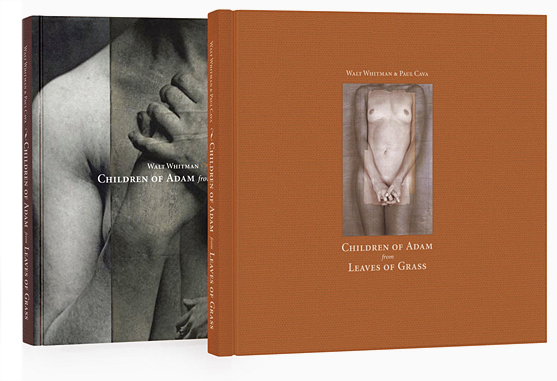
Review | DENISE WOLFF
In this beautifully crafted monograph, Paul Cava illustrates Walt Whitman’s “Children of Adam” cycle from Leaves of Grass. As a poem, Leaves of Grass rejoices in the possibilities of life and the details of the world; this is the book that Bill Clinton gave to Monica Lewinski after all. The “Children of Adam” cycle celebrates the physical world after the fall from Eden, a world of procreation and physical love between man and woman. Cava’s multilayered erotic works, containing beautifully arched bodies juxtaposed with love letters and natural elements, emphasize the possibilities of human love and share Whitman’s belief that man can be reborn through the ecstatic glorification of the body. In his photographs, vines take root in genitals, bodies meld into each other, wounds and mouths reveal pathways into the body. A particularly powerful piece features a closely cropped and upside-down Eve figure holding fruit in her hand and placed opposite a rightside- up Christ figure with a wound in his side that resembles both Eve’s lips and female genitalia. Mary’s hand visibly supports Christ in pieta, placed at the same height as Eve’s hand holding the fruit, creating the feel of a unified body. The background of wood and blood brings together two symbolic elements important to both figures, but on opposite ends of the spectrum. In this photograph, Cava, like Whitman, turns puritan ideas of chastity and sin literally upside down. In doing so, he collapses binary definitions of sacred and profane, man and woman, birth and death. Here, Christ’s flesh and Eve’s fruit are offered in parallel—perhaps suggesting a spiritual union similar to the nurturing and feeding relationship between mother and child. In both Cava’ s and Whitman’s sensual works, meanings are expansive and interrelated; the wood of the tree of knowledge and the wood of the Cross are of the same matter, just as the fall and redemption, the finite and the infinite. Cava’s illustrations are as sophisticated and joyous as Whitman’s poem. Presented together in this book, which celebrates the 150-year anniversary of Leaves of Grass, they are a treasure to own and to explore over time.
— DENISE WOLFF
